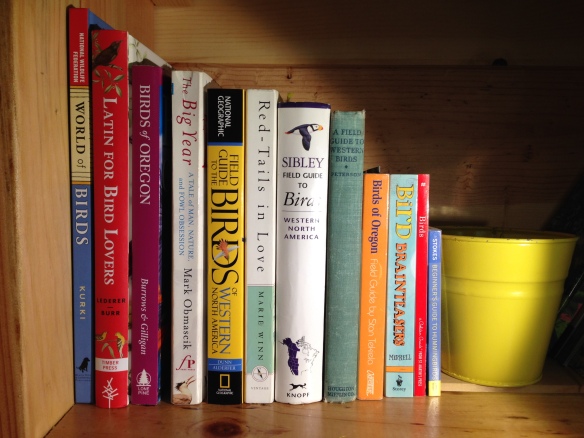Books!
This is my current bird-book library.
1. The World of Birds: A Beginner’s Guide is a fun, eye-pleasing book from the National Wildlife Federation. It contains beautiful and engaging illustrations, trivia, facts, and all sorts of information for over a hundred bird species.
2. My boyfriend, Tomas, won Latin for Bird Lovers for me in a Twitter contest presented by Timber Press. This delicately illustrated book explains and explores more than 3000 bird names. Digging deeper into the origins of names reveals connections of why birds were named the way they were. For instance, the scientific name (genus) Pelagodrama is of Greek origin for pelagos, sea, and dromos, runner, as in Pelagodroma marina, the White-faced Storm Petrel, for its habit of pattering its feet on the sea surface. Fascinating!
3. I picked up the Birds of Oregon book from a trip to the coast. I like the way this field guide is laid out, including a quick guide on the back cover and large illustrations. The book details the 328 bird species expected to Oregon annually.
4. The Big Year. What can I say. Besides having a hilarious front cover (who doesn’t want to be that guy??) this book inspired the 2011 movie with Steve Martin, Jack Black, and Owen Wilson. I picked it up at a used book shop in Seattle and am about halfway through, taking notes as I read. The book follows the 1998 North American Big Year, “the greatest – or perhaps the worst – birding competition of all time.” I enjoy the narrative pace of this adventure story, and it incorporates meaningful details about the birds seen and places traveled, as well as the eccentric birders. It’s given me insight into other birder personalities.
5. The National Geographic Field Guide to the Birds of Western North America is a new addition I picked up for Tomas last week. He hinted he would like a field guide of his own to take on his adventures. I’ve heard from others, including Laura Whittemore, birding instructor with Audubon, that the NGFG is an excellent field guide with detailed illustrations noting important field marks to look for.
6. Just the other day I came across Red-Tails in Love: A Wildlife Drama in Central Park at a used book store in Portland and couldn’t resist taking it home. The book jacket reveals this is a story about a pair of Red-Tailed Hawks that nest on the ledge of a tall building in NYC on Fifth Avenue. People become devoted to watching the hawks as they attempt to survive in the city. The author, Marie Winn, is a guest speaker in the movie Birders: A Central Park Effect.
7. The Sibley Field Guide to Birds of Western North America is my go-to field guide! This book has been my buddy since my Ornithology professor in college recommended it years ago. I’m pleased with the illustrations, the quick guide in the back, the size of the book, and so far I’ve yet to come across a bird not included. Everyone has their own preferences for field guides, and this is the one that works for me.
From an informative field guide review site:
“Peterson’s field guides have the better illustrations, they are somewhat larger and more color saturated than the Sibley series. The Peterson’s series also include sections highlighted in bold for “Similar species” and “Habitat”, Sibley’s does not include these sections.
The Sibley’s series has more varied illustrations of individual species, including many more in-flight illustrations than the Peterson guides provide. Sibley’s also has the better field mark notations that include pointers and textual information surrounding the subject. Peterson’s just includes pointers to the field marks.”
8. When I attended the waterfowl outing hosted by Audubon, the group leader and longtime birder, Ron Escano, recommended finding an older Peterson guide since it includes black and white bird illustrations. This is helpful for identifying birds in poor light or bad weather conditions. Pretty useful for winter in Portland. I lucked out finding a 1941 version of A Field Guide To Western Birds Peterson guide at a used book store in town. I plan on enlarging/laminating key pages to make it more useful in the field.
9. Birds of Oregon is a handy little guide that has bird photographs rather than illustrations. It might seem counter-intuitive, but illustrated guides are favored over photographs because illustrations emphasize important field marks that photographs might miss due to lighting, camera angle, or subtle variations. It’s generally recommended to have (at least) two field guides, one with illustrations and one with photos to use as a cross-reference. I have another edition, Birds of the Willamette Valley Region, on my wish list.
10. Bird Brain-Teasers: Puzzles, Games, & Avian Trivia is AWESOME. This book combines birds and puzzles, two of my favorite loves. I only wish it would last forever.
11. A teeny tiny Golden Guide to Birds contains illustrations and notes on 129 common birds of North America, where/when to find them, how to attract them, and what to look for. I picked it up from Audubon gift center for supplemental reading.
12. Last but not least is a Stokes Beginner’s Guide to Hummingbirds. It’s small, includes photographs, and looks pretty thorough. We have hummingbird feeders up in the yard, but I’ve yet to need the guide since the only resident winter hummingbirds we have are Anna’s. I’m hoping to see a few more species this summer!
Happy reading!
Tweets and chirps,
Audrey


Loved Redtails in Love because it brought all types of people together, the rich and poor shared a common experience.
It’s true! Kind of amazing when that happens.